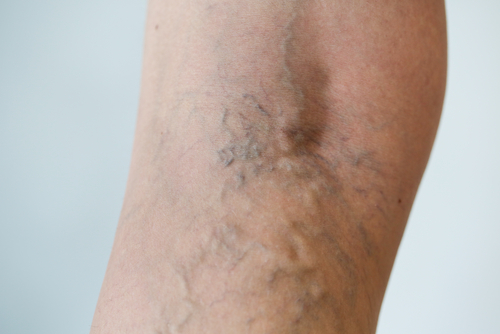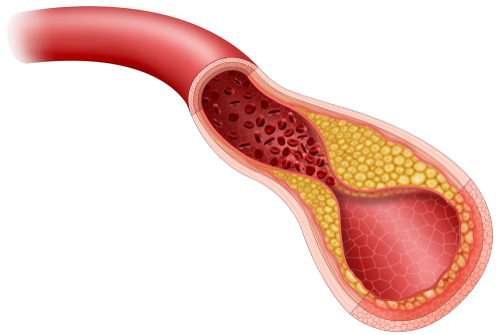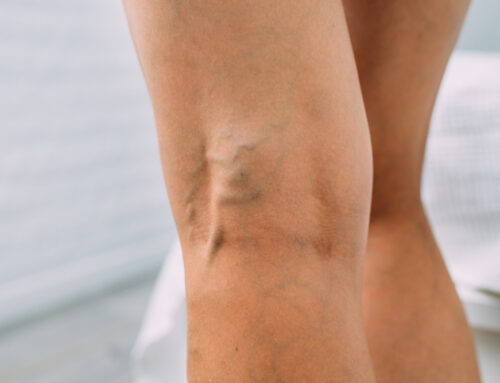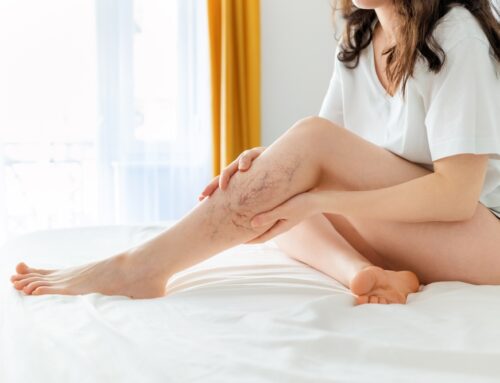We use our legs on a daily basis for anything you can imagine, and maintaining your leg health is important to make sure you can tackle every day. If you notice your legs are feeling heavy or painful, there are multiple reasons that can explain your symptoms.
A major component of leg health is efficient blood circulation. Your muscles use your oxygen-rich blood to feed your muscles, and without proper oxygen your muscles become prone to muscle fatigue. Fatigued muscles feel heavy and tired, which makes it hard to keep moving throughout the day.
There are a few common causes of heavy legs, such as:
- Overtraining
- Chronic Venous Insufficiency
- Varicose and Spider Veins
- Peripheral Artery Disease
Today we’ll talk about what heavy legs could be saying about your vein health and what can be done about it.
Why Do My Legs Feel Heavy?
Have you ever experienced a feeling of heaviness or aching in the legs? This feeling could have been at any time of day – either while sitting or moving. If you have, know that it’s not an uncommon occurrence.
A feeling of heaviness in the legs can occur due to various medical conditions. Today, we will talk about a few of the possible causes of this feeling.
Overtraining
The simplest and least worrisome reason for heaviness in the legs is a one-off case of overtraining. If you’ve recently completed a strenuous round of exercising and have no other visible symptoms, the heaviness in your legs might be normal.
Suppose, however, this heaviness is a common occurrence that does not pass, or it flares up over minor physical activity. In that case, you should consult with a vein specialist as soon as possible.
Chronic Venous Insufficiency
To start with, let’s introduce the term Chronic Venous Insufficiency (otherwise known as CVI). This is a commonly used term to describe the inability of blood to flow properly through your veins.
What is commonly seen in cases of patients with CVI is that vein valves malfunction and are unable to properly push blood along. As a result, blood stagnates and pools in pockets throughout your veins instead of circulating back up to your heart.
Another detail to note is that although chronic venous insufficiency is a venous condition, it’s more of an encompassing category of medical conditions. Below, we will go over some of the conditions related to it.
Related: What Is Chronic Venous Insufficiency?
Varicose And Spider Veins

Perhaps the two most commonly associated conditions with CVI will be varicose and spider veins.
Varicose Veins
Afflicting millions of adults in the US alone, varicose veins are one of the most common health conditions in the world today. Fortunately, however, most varicose vein conditions pose little to no risk to your physical health.
Generally speaking, varicose veins can be identified by enlarged or bulging veins that appear bluish-purple in color. Additional symptoms may include itching, achiness, or a heavy feeling in the legs.
Related: What Are Varicose Veins?
Spider Veins
Put simply, spider veins are a lesser version of varicose veins. Spider veins can typically be identified by the appearance of small, thin veins spread out in a web-like pattern. Similar to varicose veins, they will appear to be a bluish-purple hue. Keep in mind, however, that if a vein is large or bulging, it is most likely not a spider vein.
Related: What Are Spider Veins?
Both varicose and spider veins are easily removed with the help of a sclerotherapy which works to remove these veins by putting a chemical solution directly into the targeted vein.
Peripheral Artery Disease (PAD)

Another possible cause of heaviness in the legs is a less common disease called Peripheral Artery Disease (otherwise known as PAD).
PAD is a type of cardiovascular disease that occurs when fat deposits begin clogging up your arteries. As a result, blood flow is greatly restricted, and your circulation slows down.
Unlike other vein conditions, PAD typically occurs as a direct result of atherosclerosis and has a much clearer root cause.
The most common contributing factors to the development of atherosclerosis are obesity, diabetes, high blood pressure, high cholesterol, and other unhealthy lifestyle habits. In short, the healthier you are, the lower your risk of developing PAD.
What Risks are Associated with Untreated PAD?
Peripheral Artery Disease (PAD) can lead to several serious health complications if left untreated. Here’s what you need to know:
- Progressive Symptoms: As PAD worsens, it can result in increasing discomfort and pain, particularly in the legs. This is due to the diminishing blood flow to the affected areas.
- Formation of Ulcers: Persistent reduced circulation can cause ulcers and open sores to develop, which are slow to heal and may become infected.
- Risk of Amputation: Severe untreated PAD heightens the risk of tissue death, which may ultimately necessitate amputation of the affected limb.
- Increased Cardiovascular Risk: PAD is often indicative of widespread arterial disease, meaning individuals are at a heightened risk for other cardiovascular issues like heart attacks and strokes.
Monitoring and treating PAD early can significantly mitigate these risks, promoting better overall health and quality of life.
Diagnostic Tests to Determine the Cause of Heavy Legs
If you’re experiencing heavy legs, various diagnostic tests can help identify the underlying vascular issues. Here are some commonly used methods:
1. Ultrasound Imaging
Ultrasound is a non-invasive test that uses sound waves to create images of the blood vessels in your legs. This helps healthcare providers see if there are any blockages or abnormalities.
2. Doppler Ultrasound
A specific type of ultrasound, Doppler ultrasound, measures blood flow through your veins and arteries. This can indicate if there’s a reduction in blood flow contributing to the heavy feeling.
3. Ankle-Brachial Index (ABI)
The Ankle-Brachial Index test compares the blood pressure in your ankle with the blood pressure in your arm. A lower score could suggest blocked arteries, which might be causing the sensation of heavy legs.
4. Venography
In venography, a special dye is injected into your veins before taking X-rays. The dye makes the veins more visible on the X-ray images, helping the doctor see any potential blockages or issues.
5. Magnetic Resonance Angiography (MRA)
MRA uses magnetic fields and radio waves to create detailed images of your blood vessels. This test can help diagnose blockages or other abnormalities affecting blood flow to your legs.
What to Expect
During your initial evaluation, your healthcare provider will decide which of these tests is most appropriate based on your symptoms and medical history. Early diagnosis and treatment are crucial to managing vascular issues and alleviating the discomfort associated with heavy legs.
By identifying the specific cause, these diagnostic tests pave the way for a targeted treatment plan, ensuring better health outcomes and improved quality of life.
Treatment For Heaviness In Legs
Now that we’ve established what heaviness in the legs might mean for your health let’s talk about how to fix it.
First of all, try to visit a vein specialist as soon as possible if you start experiencing persistent symptoms of achiness, itchiness, or heaviness in the legs.
Here at VeinSolutions™, we offer FREE vein screenings. During one of our vein screenings, a vein specialist will assess your symptoms and recommend a course of treatment.
If your symptoms are related to varicose or spider veins, your doctor will most likely recommend a minimally invasive procedure to treat the condition. Some common procedures for varicose veins include sclerotherapy, venous ablation, and microphlebectomy. All of these procedures can be performed in under an hour and require little to no recovery time.
Treatments for Flawless Vein-Free Legs
If, however, your symptoms are related to a condition such as PAD, your doctor may also recommend lifestyle changes. These could include things like eating healthy, weight loss, or staying physically active.
What Are the Long-Term Outcomes of Untreated Heavy Legs?
Untreated heavy legs can lead to serious complications over time, depending on the underlying cause.
Venous Disease
When heavy legs are due to venous disease, the condition can progressively worsen. This might result in:
- Increased Severity of Symptoms: Swelling and skin discoloration may become more pronounced and harder to reverse.
- Reduced Mobility: The pain and discomfort can significantly impact your ability to stay active.
- Higher Risk of Deep Vein Thrombosis (DVT): This serious condition, involving blood clots, can arise from untreated venous disease.
Arterial Disease
If arterial disease is the root cause, the ramifications can be even more severe:
- Development of Sores and Ulcerations: Reduced blood flow can lead to open sores, which are difficult to heal.
- Risk of Amputation: Prolonged untreated peripheral artery disease (PAD) can drastically increase the risk of needing an amputation due to severe tissue damage.
It’s crucial to consult your healthcare provider to form an appropriate treatment plan. Early intervention can significantly alter the trajectory of these conditions, improving quality of life and preventing serious complications.
What Happens if Vascular Disease is Left Untreated?
Leaving vascular disease untreated can have significant long-term effects, depending on whether it’s related to venous or arterial issues.
Consequences of Untreated Venous Disease
Untreated venous disease often leads to progressively worsening symptoms. These can include:
- Increased Swelling: Legs may swell more, making mobility difficult.
- Skin Discoloration: Changes in skin color might become irreversible.
- Elevated Risk of DVT: Deep vein thrombosis (DVT), or blood clots, becomes more likely without timely intervention.
Chronic symptoms like these can severely impact your overall activity levels due to discomfort and limited mobility, as well as your quality of life.
Consequences of Untreated Arterial Disease
If arterial disease goes untreated, the risks are equally severe. Potential outcomes include:
- Open Sores or Ulcerations: Reduced blood flow can lead to the development of sores that are slow to heal.
- Risk of Amputation: Persistent poor circulation can necessitate amputation to prevent further complications.
It’s clear that the progression of arterial disease can result in serious and life-altering consequences.
The Importance of Medical Consultation
The key takeaway is to stay proactive about your health. Early diagnosis and management with a healthcare provider can prevent these severe outcomes. Developing a treatment plan with your doctor is crucial for maintaining your health and preserving your quality of life.
How to Manage Heavy Legs After Treatment
Long-Term Follow-Up
Managing heavy legs effectively after treatment involves consistent follow-up with your healthcare provider. Given that vascular disease is a chronic condition, it’s crucial for your doctor to monitor your progress over time. Regular check-ups may involve routine ultrasound studies and other diagnostic tests to ensure effective management.
Lifestyle Adjustments for PAD
If you have Peripheral Artery Disease (PAD), making specific lifestyle changes can prevent further episodes of heavy legs. Here are some recommended adjustments:
- Exercise Regularly: Incorporate daily physical activities such as walking, swimming, or cycling into your routine.
- Healthy Diet: Shift to a diet low in saturated fats and cholesterol, while rich in whole grains, fruits, and vegetables.
- Medication: Your doctor may prescribe medications like aspirin or antiplatelet drugs to help blood flow. You might also need medication for blood pressure, glucose levels, and cholesterol control.
- Avoid Smoking: Smoking exacerbates PAD and can detrimentally affect your treatment outcomes, making it essential to quit.
Managing Venous Disease
For venous diseases, maintaining venous health is key. Here are some steps to follow:
- Compression Stockings: Continue wearing compression socks or stockings to support your veins and reduce symptoms.
- Regular Exercise: Stay active with exercises that promote circulation, such as walking or light aerobics.
- Healthy Weight: Maintain a balanced diet to keep a healthy weight, further supporting vascular health.
Additional Recommendations
- Hydration: Drink plenty of water throughout the day to keep your blood circulation optimal.
- Elevate Your Legs: Periodically elevating your legs can help reduce heaviness and improve blood flow.
- Routine Monitoring: Stick to the routine check-ups and tests your doctor recommends to monitor your condition effectively.
By following these strategies, you can better manage heavy legs and improve your overall vascular health.
Frequently Asked Questions
We hope that this article helped answer some of your questions regarding heaviness in the legs. Just in case, however, here are a few more FAQ’s from us.
What Does It Mean When Your Legs Feel Heavy?
Heavy legs can sometimes be a symptom of a vein condition. Common vein conditions such as chronic venous insufficiency, PAD, varicose veins, and spider veins can all cause your legs to feel heavy.
If the sensation of heaviness persists longer than a day or is accompanied by any physical symptoms such as bulging or bluish-purple veins, it’s best to consult with a vein specialist.
Likewise, if you begin to experience other symptoms of discomfort such as itching, aching, or pain, you should immediately consult with a medical professional.
What Vitamin Deficiency Causes Heavy Legs?
Deficiencies in vitamins such as D or B-12 might have a fatiguing effect that is similar to the feeling of heaviness in the legs. Having said that, consistent heaviness in the legs is more likely to result from a vein condition such as varicose or spider veins.
Why Do My Legs Feel Heavy When I Run?
Heaviness in the legs during physical activity is most likely the result of not having enough blood circulating. This heaviness can be caused by conditions such as varicose veins or PAD.
Heaviness in the legs can also be associated with athletes that overtrain. Exercising vigorously every day may not give your leg muscles enough time to recuperate, resulting in that heavy feeling. If this is the case, try to take breaks in between exercise sessions and train more moderately. This will give your muscles the chance to recuperate in between training sessions.
If, however, you feel pain or experience other concerning symptoms, don’t hesitate to consult with a medical professional.
What Are Heavy Legs A Symptom Of?
As mentioned earlier, heavy legs can be a symptom of a variety of different conditions such as varicose veins, chronic venous insufficiency, PAD, overtraining, and more.
The best way to find the root cause of your symptoms is always to consult with a medical professional. A vein specialist will be able to perform a physical examination and/or a venous ultrasound to diagnose your condition.
What Is Restless Leg Syndrome?
Restless leg syndrome is an uncomfortable condition that is defined by an uncontrollable urge to move or shift the legs. Most patients that are diagnosed with this condition report uncomfortable symptoms such as itching, crawling, creeping, tingling, aching, or throbbing in the legs. Movement typically helps ease symptoms temporarily, therefore earning the condition its name.
Vein Clinic Near Me
Are you looking for a highly-qualified vein specialist in the Michigan area? Look no further! Here at VeinSolutions™, we offer a staff with over 50 years of experience and medical knowledge. Even more importantly, however, we offer a staff that cares about their patients.
Our vein clinic offers a variety of treatments such as sclerotherapy, venous ablation, or microphlebectomy. In addition to all this, however, we also offer FREE vein screenings. This way, you’re able to come in and get your symptoms assessed without worrying about any consultation fees.
Simply call or visit our website to book your appointment today. For your convenience, VeinSolutions™ offers locations in Flint, MI, and Lapeer, MI.
Request A Consultation
Give Us A Call:
(810) 232-3363
Give Us A Call:
(810) 232-3363



